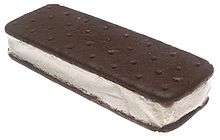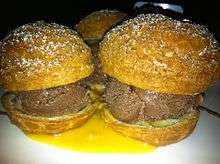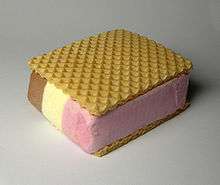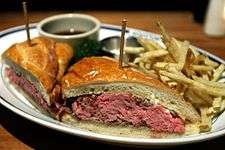Ice cream sandwich
An ice cream sandwich is a frozen dessert consisting of ice cream between two biscuits, wafers, or cookies.
 | |
| Type | Ice cream |
|---|---|
| Main ingredients | Ice cream or cookies |
Australia
Within Australia, popular brands are Giant Sandwich (blue and pink wrapper), and Monaco Bar (gold and black metallic wrapper) in the Eastern states. Other brands include Streets "Cookie", Maxibon (with one-half ice cream sandwich) and Maxibon Cookie, and Pat and Stick's Homemade range (recognizable by its circular shape).[1]
Ice cream sandwiches were formerly known as a "cream between". One purchased a small block of ice cream wrapped in paper and placed it between two wafers.
Iran
The usual Iranian ice cream sandwich is called bastani naani (بستنی نانی) meaning "bread-ice cream", and is made with Iranian traditional ice cream between two wafers.[2]
North America
In North America, an ice cream sandwich is a block of ice cream, usually vanilla although other flavors can be used, sandwiched between two rectangular cookie wafers (usually chocolate-flavored), and normally rectangular in shape.
The earliest mentions come in 1899. Street vendors in New York previously sold slabs of ice cream between sheets of paper, called "hokey pokeys", until someone had the idea of using cookies instead.[3] Photos from the Jersey Shore circa 1905 show ice cream sandwiches being sold at 1¢ each.[4] The earliest US patent having to do with ice cream sandwiches (No. 1,387,613) is by Russell H. Proper for an "Ice Cream Sandwich Machine" in 1921.[5] A Chipwich, where ice cream (usually vanilla) is sandwiched between two chocolate chip cookies, is also popular.
A "National Ice Cream Sandwich Day" is set for August 2,[3] and has been celebrated at least since 2005.[6]
Israel
In Israel, ice cream sandwiches are commonly known as "kasata" (קסטה). Though the name comes from the Italian cassata, the dessert itself has little to do with Italian cassata, and usually consists of two thick biscuits holding a mix of block of vanilla and chocolate flavored ice cream.
Philippines

Local ice cream sellers/peddlers with their pushcarts that travel around cities sometimes offer ice cream sandwiches with pandesal as the bread.
Singapore
Wafer ice cream is a type of ice cream popular in Singapore, often known as potong (cut) ice cream, which consists of two wafers holding together a block of ice cream. (This is not to be confused with commercially available 'ice potong', which is a rectangular prism of ice cream mounted on a wooden stick.) Vendors are commonly found along Orchard Road and Chinatown and outside schools. A colloquial term for it is "pia ice cream", which translates to "biscuit ice cream" in the Hokkien dialect.
Common flavours offered include ripple, red bean, yam, sweet corn, durian, honeydew, peppermint, chocolate, and chocolate chip.
Wafer ice cream vendors also sell the same blocks of ice cream on slices of multicolored bread, on cones or in cups instead of sandwiched between wafers.
The ice cream block is essentially a huge log of ice cream, which is then cut (hence the name potong) and sandwiched between two wafers. There are differences between countries: Singaporean street vendors do not offer individually wrapped ice cream sandwiches like Australia does.
United Kingdom
In the United Kingdom an ice cream wafer, consisting of a small block of ice cream between two rectangular wafer biscuits, was a popular alternative to a cone up until the 1980s. Since then it has declined and is now rarely seen. A "nougat wafer" was also available, consisting of a layer of nougat sandwiched between two wafers and coated with chocolate around the edges. Typically a vanilla block (or a layer of soft-serve) sandwiched between one plain wafer and one chocolate-covered nougat one. Nougat wafers came in double or triple varieties, depending on the number of nougat wafers in the construction.
Ireland

In Ireland they are known as "sliders" or an ice cream wafer, and are usually served as vanilla ice cream sandwiched between two rectangular chocolate wafers. A "double nougat" is ice cream sandwiched between two nougat wafers. The wafers are not covered in chocolate, only the edges.
Germany
In Germany ice cream sandwiches are made with two wafers and the three flavour combination called Fürst-Pückler-Eis, elsewhere known as Neapolitan ice cream. It is based on a recipe introduced in 1839 by the cook of a German nobleman, Prince Hermann Ludwig Heinrich von Pückler-Muskau.
Uruguay
In Uruguay an ice cream sandwich (sánguche helado) or triple sandwich (sánguche triple) is typically a neapolitan ice cream (helado triple) sandwich prepared with wafers such as the one in the image.
Vietnam
In Vietnam, an ice cream sandwich called bánh mì kẹp kem is commonly sold on the street as a snack. It consists of scoops of ice cream stuffed inside a bánh mì, topped with crushed peanuts.[7]
See also
- Cookie sandwich
- Ice cream
- Maxibon
- It's-It Ice Cream
- Oreo
- Chipwich
- List of sandwiches
References
- Taffel, Jacqui. "Ice little earner", The Sydney Morning Herald, February 7, 2006.
- "بستنی سنتی زعفرانی". iranchef. Archived from the original on 25 October 2013. Retrieved 9 April 2014.
- Devra First, "Birth of the cool: The story behind the ice cream sandwich, an icon at 120", Boston Globe, July 30, 2019
- "Endless Summer: 1905 | Shorpy Historical Photo Archive". Shorpy.com. Retrieved 2012-09-20.
- "Patent Images". United States Patent and Trademark Office. Retrieved 17 July 2019.
- Norman Kolpas, Practically Useless Information on Food and Drink, ISBN 1418553891
- "Sài Gòn: Mua 'vé về tuổi thơ' với bánh mì kẹp kem siêu rẻ" [Saigon: Purchase a "ticket to childhood" with super-cheap ice cream sandwiches]. Trí Thức Trẻ (in Vietnamese). Hội Trí thức Khoa học và Công nghệ Trẻ Việt Nam. April 18, 2013. Retrieved March 25, 2014.
External links
| Wikimedia Commons has media related to Ice cream sandwiches. |
- First, Devra (30 July 2019). "Birth of the cool: The story behind the ice cream sandwich, an icon at 120". BostonGlobe.com.

